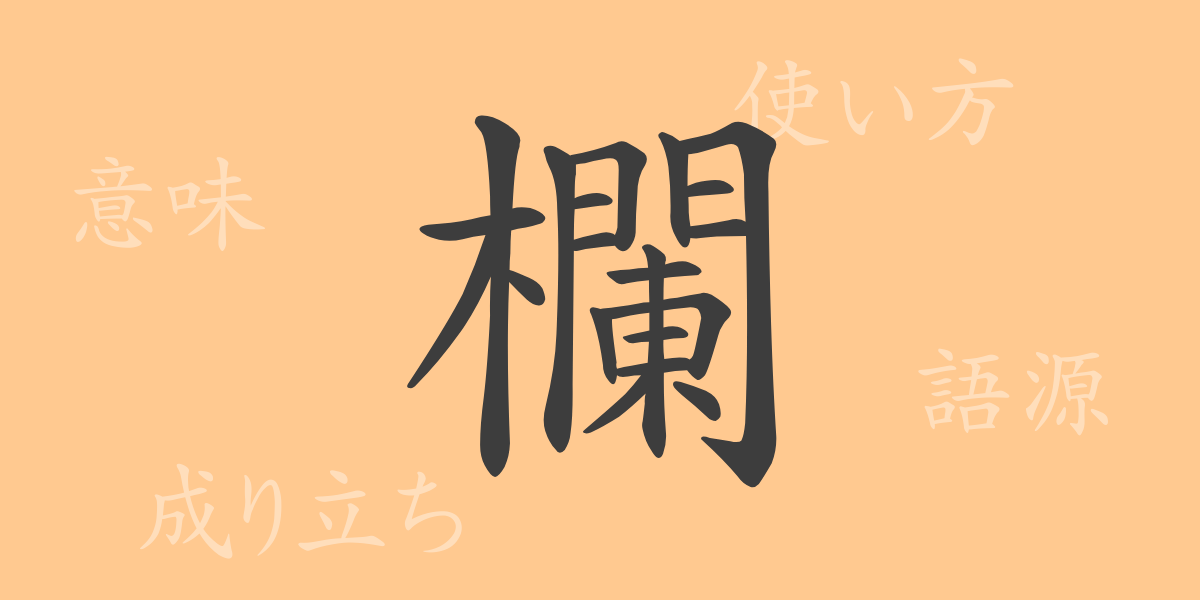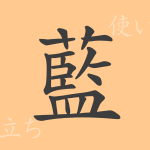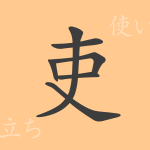The culture and language of Japan are deeply interwoven with many kanji (漢字, kanji). These characters are not merely symbols but carry profound meanings and histories, closely tied to the lives of the Japanese people. Today, we will focus on the kanji “欄” (らん, ran), unraveling its charm and significance. As a commonly used kanji, “欄” (らん, ran) appears frequently not only in newspapers and books but also in everyday life. In this article, we will explore the origin, meaning, usage, and even compound words and idioms involving “欄” (らん, ran), revealing its full scope.
Origin of 欄 (らん, ran)
The kanji “欄” (らん, ran) is an ancient character passed down from ancient China, and its origin is quite fascinating. “欄” (らん, ran) is composed of “木” (き, ki) and “闌” (らん, ran), with the original meaning being “栏杆” (らんがん, rangan), which signifies “fence” or “railing.” In ancient times, it referred to the fences around palaces or temples, and over time, it evolved to mean partitions or columns. As time progressed, “欄” (らん, ran) transcended its literal physical barrier meaning and began to be used as a concept for partitioning information or text.
Meaning and Usage of 欄 (らん, ran)
In modern Japanese, “欄” (らん, ran) is primarily used to denote frames or columns for dividing something, or to specify particular sections. For instance, in newspapers and magazines, it is used in terms like “記事欄” (きじらん, kijiran) meaning “article section” and “広告欄” (こうこくらん, koukokuran) meaning “advertisement section,” playing a role in organizing information and making it visually easier to read. Additionally, in various forms and surveys, it is widely used as “記入欄” (きにゅうらん, kinyuran) meaning “entry field” or “回答欄” (かいとうらん, kaitouran) meaning “answer field,” indicating spaces for inputting information.
Reading, Stroke Count, and Radical of 欄 (らん, ran)
“欄” (らん, ran) has multiple readings in Japanese, depending on the context in which it is used.
- Reading: In on’yomi (音読み, onyomi) it is “ラン” (らん, ran), with no specific kun’yomi (訓読み, kunyomi)
- Stroke Count: It has a total of 20 strokes
- Radical: It is classified under the “木” (き, ki) radical
Compound Words, Idioms, and Proverbs Using 欄 (らん, ran)
There are many compound words, idioms, and proverbs in Japanese that include “欄” (らん, ran). For example, “欄外” (らんがい, rangai) refers to annotations or supplements written outside the main text, and “名簿欄” (めいぼらん, meiboran) indicates a part of a list containing names or contact information. Additionally, the phrase “花の慶次 -雲のかなたに-” (はなのけいじ -くものかなたに-, Hana no Keiji -Kumo no Kanata ni-) is the subtitle of the popular manga “花の慶次” (はなのけいじ, Hana no Keiji), suggesting that the story’s setting is beyond the clouds, in a distant world. These expressions each utilize the meaning of “欄” (らん, ran), showcasing the richness of the Japanese language.
Summary of 欄 (らん, ran)
Understanding the meanings and histories embedded in each kanji is crucial for deepening one’s comprehension of the Japanese language. “欄” (らん, ran) is one such kanji, a versatile character used in various everyday contexts. From article sections in newspapers to entry fields in documents, “欄” (らん, ran) is omnipresent in our surroundings. Through this article, we hope you have learned about the diverse meanings and usages of “欄” (らん, ran) and can enjoy its application even more.

























